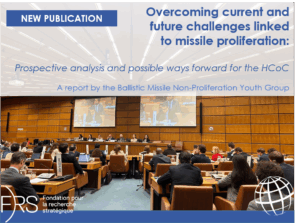The Rise of Small Launchers: What Impact on Ballistic Missile Proliferation?
HCOC RESEARCH PAPERS NO. 13
The link between space launchers and ballistic missiles, in connection with the risk of ballistic proliferation, is a recurring theme that has become more acute in recent years. The number of small launcher projects and programmes has grown dramatically, and many countries now have the industrial capacity to develop the required technologies.
This paper observes that small launcher programmes have increased sharply in recent year. The question of the potential transformation of these vehicles into military delivery systems has arisen on numerous occasions, as manufacturers are increasingly gaining mastery of the technologies necessary for the development of small launchers. However, to date, there is no known case of a small launcher having been converted into a ballistic missile, not even in North Korea or Iran. Nonetheless, there are many similarities between launchers and ballistic missiles, especially in technical terms. Past examples of FOBS programmes demonstrate that it is possible to plan, from the initial design stage, for a core technology common to small launchers and ballistic missiles. Additionally, suborbital flights, clearly show that space launchers can adopt a ballistic flight trajectory if necessary. This is the best proof that a launcher can be converted into a ballistic missile, even if the differences between the two types of vehicles remain significant, preventing a simple and complete transfer from one spacecraft to the other.
While the small launcher landscape is in rapid evolution, a few programmes are likely to prove sustainable in the long run, justifying putting regarding closely developments, technological progress, and industrial capabilities in the countries concerned, as well as those that do not yet have long-range missiles or space launchers.
APRIL 2024
Christian Maire
OBJECTIVES AND STRUCTURE OF THE STUDY
“The number of small launchers has increased further over recent years, although they are at very different stages of development, ranging from initial projects to being in operational use. Access to space has developed considerably, and by 2023 there will be around 178 small launcher programmes. But for most of them the future is rather uncertain.”
The question of the link between space launchers and ballistic missiles, in connection with the risk of ballistic proliferation, is a recurring theme that has become more acute in recent years owing to the considerable increase in the number of small launchers. The number of small launcher projects and programmes has grown dramatically, and many countries now have the industrial capacity to develop the required technologies, giving them potential or actual access to space. The format of these small launchers, comparable to that of long-range ballistic missiles, makes the issue even more concerning. The question therefore arises of whether these developments in launcher technologies could potentially be linked to the possibility of deriving ballistic missiles from small launchers—missiles which, moreover, would be intercontinental in range.
This study sets out from four observations:
- Access to space is undergoing major transformations: in recent years, the number of space launchers, as well as the number of satellites, has grown considerably, and this trend is measurable. Barriers to entry for launch have been lowered by the emergence of numerous satellite constellation programmes, and demand for launches and reduction in the size of satellites have prompted a large number of private initiatives to set up launcher programmes, contributing to the so-called New Space race. It is therefore useful to clarify what role small launchers are playing in this context.
- Space launchers and ballistic missiles apparently have a great deal in common. We therefore need to explore in more detail the similarities and differences between these two types of delivery systems, both of which provide access to space, in order to identify more precisely the areas in which there may be complementarities.
- In examining the links between launchers and missiles, we find that the cases we can identify mainly involve the conversion of missiles into launchers, and rarely the other way around. However, it is necessary to make sure we have up-to-date information on this subject.
- This raises the question of whether we should have any worries for the future, given that the past shows that fears around the risk of proliferation have not been borne out. It is therefore important, before arriving at any conclusions, to examine a number of case studies of certain countries, as well as different approaches to this question.



